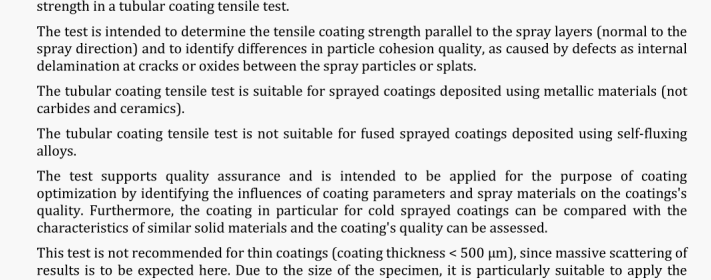Thermal spraying

BS EN 17393:2020 pdf free.Thermal spraying一Tubular coating tensile test.
The base samples are made of aluminium or non alloy steel. Their outer dimensions shall be equal to those of the specimens used in the determination of tensile adhesive strength according to EN ISO 14916 (diameter: 25 mm or 40 mm), and they have a central bore [6 mm through bore) for fixation, see Figure 2. Rounding or chamfering the front face is not permitted.
Install the base samples in the fixture, see Figure 3, and adjust them to the maximum common diameter (tolerance土0,02 mm) using a lathe. A uniform surface quality Rz of about 40 um shall be achieved. This
type of levelling is important, because otherwise a discrepancy between the two cylinders would significantly weaken the coating that is to be applied. The diameter that is reached, D;, which is represented in the drawing as the outer diameter of the specimen (underneath the coating), shall be recorded.
5.3 Specimen to be sprayed, preparation and coating
The preparation of the specimen to be sprayed as well as the spraying parameters, such as the spraying procedure, spray material, coating thickness, energy data, movement pattern, etc.. shall be in accordance with the specifications for the spraying procedure of the corresponding workpiece, if any.
The rotating specimen to be sprayed shall be coated over the entire length of its outer surface. The temperature of the specimen to be sprayed shall under no circumstances exceed those values reached when spraying the corresponding workpiece, if any, which can occur particularly when applying coatings of larger thicknesses. The sprayed specimen shall be removed from the fixture and the central fixing screw shall be taken out. Then the specimen can be directly tested in a tensile testing machine using the same clamping devices as in the tensile adhesive strength test according to EN ISO 14916. See Figure 1 in Clause 4.
5.4 Determination of outer diameter
After spraying, and before the test, the outer diameter shall be measured in at least 3 points along the surface of the cylinder length of the spray specimen, where one section shall be on the junction between the base samples. For each measurement section, the diameter shall be measured rotated by 900, and the mean value shall be calculated.
The maximum diameter tolerance is ± 0,01 mm.
Only suitable instruments, which need to be calibrated and traceable to national standards, shall be used during measurement. They shall be capable of measuring the diameter with an accuracy of at least 0,01 mm.
5.5 Number of specimens to be tested
Three specimens, which have been coated in one spray cycle using identical process parameters, shall be tested.
6 Test procedure
The specimen, with attached clamping arrangement, is inserted torque-free and bending-free into the tensile testing machine and loaded in tension at a constant rate and shock-free until fracture occurs.
The yoke moves at a speed of (1 ± 0.24) mm/mm or (0,017 ± 0,004) mm/s until breakage occurs. The maximum load Fm, in kN shall be recorded.
Testing is performed at room temperature. For a series of tests, equal test conditions shall be ensured.
7 Possible sources of fault during procedure
Possible sources can be:
a) irregular coating thickness;
b) coating thickness is too small;
c) coating thickness is too large;
d) testing speed is too high;
e) clamping Inside the tensile testing machine not torque-free or bending-free.
8 Evaluation
When loaded in tension, the geometrical arrangement of base samples and the coating causes stress concentrations at the front faces of the base sample as a result of the notch effect. This shall be taken into account for comparison with conventional tensile tests. The notch factor K has been determined by simulations based on FEM and verified by experiments.
The following shall be documented in the test report for each specimen:
a) reference to this standard, i.e. EN 17393:2020;
b) inspection body, examiner, date;
c) material of the base samples;
d) specification of the spray material;
e) preparation of the base sample surface to be coated;
f) spraying procedure;
g) thickness of coating (tolerance:土0,01 mm);
h) designation of specimen and diameter (Da and D; tolerance:土0,01 mm);
i) tensile strength in MPa for each single specimen as well as the averaged value of the three specimens of a series;
i) standard deviation;
k) results of the metallographic inspection or reference to its report number.
An example of a test report is given in Annex A (informative).BS EN 17393 pdf download.Thermal spraying